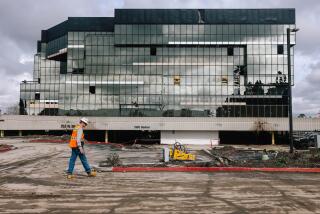Ralphs : Chain’s Distribution Goes High-Tech : Computers Help New High-Rise Supply Outlets
- Share via
When George A. Ralphs opened his first store at Sixth and Spring streets in downtown Los Angeles in 1873, grocery distribution was a simple matter.
All items were housed in the rear of the store, and home deliveries were made by horse and buggy.
Today, Mr. Ralphs would gawk if he could see his company’s new 170,000-square-foot, state-of-the-art warehouse off the Golden State Freeway near Glendale, where workers are busily loading wooden platforms, or pallets, of groceries into bright blue, 103-foot-high racks that actually support the structure’s roof.
Begun in June, 1985, and built at a cost of more than $50 million, the high-rise warehouse is just starting operations, its 125,000 square feet of space storing what would require 825,000 square feet of conventional warehouse space. According to Ralphs Grocery of Compton, it takes 2,500 truckloads to fill the entire warehouse with groceries. That’s roughly enough food to feed 450,000 families for a week.
Sleek yellow “stacker cranes,” each weighing 25 tons, are used to hoist heavy pallets of merchandise to the rafters or to place them gently at floor level. The cranes, operated by IBM computers, travel horizontally at 500 feet per minute or vertically at 120 feet per minute, and stock 55,000 pallet spaces. (Conventional, non-automated cranes can lift objects only 30 feet.)
“The inventory is on-line all the time,” said Ralph H. Liebman, executive vice president. “The computer knows what’s here.”
Once the computer tells the crane to retrieve a pallet, the groceries are placed on a mile-long conveyor belt, winding up at an adjoining warehouse area. There the goods are loaded manually onto Ralphs trucks for shipment to one of the company’s 112 supermarkets or 14 Giant warehouse stores.
According to Liebman, the new warehouse has eliminated the need for four of five satellite warehouses and should see Ralphs well into the future. Given that the “seismically designed” building is in “a high-degree fault zone,” Liebman said, the company was relieved to lose only two pallets of goods in the Oct. 1 earthquake. “The building did what it was supposed to--flexed without throwing everything down.”
More to Read
Inside the business of entertainment
The Wide Shot brings you news, analysis and insights on everything from streaming wars to production — and what it all means for the future.
You may occasionally receive promotional content from the Los Angeles Times.











